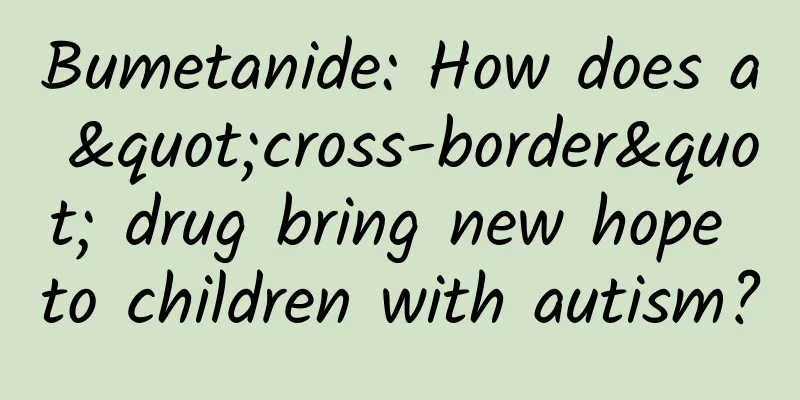Bumetanide: How does a "cross-border" drug bring new hope to children with autism?

|
Autism spectrum disorder (ASD) is a complex neurodevelopmental disease that affects approximately 1% of children worldwide. For a long time, drug treatment has focused on relieving symptoms, such as using antipsychotics to improve aggressive behavior and antidepressants to relieve anxiety, but these drugs cannot address the cause of the disease. In recent years, bumetanide, an "old drug" originally used to treat edema, has unexpectedly come into the field of vision of autism researchers. This article will analyze the mechanism and application prospects behind this cross-border drug from a scientific perspective. 1. The past and present of Bumetanide Traditional Use: Kidney Drainer Bumetanide has been used as a potent diuretic since the 1970s. It inhibits the sodium-potassium-chloride (Na-K-Cl) co-transporter in the kidneys to promote water excretion and is often used to treat edema caused by heart failure and hypertension. It has become a commonly used drug in pediatrics because of its small side effects and low price. Cross-border discovery: from "drainage" to "power regulation" Since 2010, French scientists have found in animal experiments that bumetanide can regulate the chloride ion concentration of brain neurons. Under normal circumstances, the chloride ion level in the brain of a newborn is high and gradually decreases with development. However, the chloride ion concentration in the brain of some children with autism is abnormally high, leading to dysfunction of the inhibitory neurotransmitter GABA - the signal that should have "brakes" instead "accelerates", causing abnormal perception and social disorders. This discovery provides a theoretical basis for the "cross-border" application of bumetanide: by regulating chloride ion homeostasis, it may restore the normal function of GABA and thus intervene in the core symptoms of autism. 2. Scientific Verification: From Laboratory to Clinic Key research: Breakthrough results from a Chinese team In 2021, Professor Li Fei's team at Shanghai Jiao Tong University published a landmark study in Science Bulletin. They conducted a three-month double-blind controlled trial on 120 children with autism aged 3-6 years old. The results showed that children taking bumetanide showed significant improvements in core symptoms such as social communication and sensory abnormalities, without any serious side effects. Imaging evidence: "Electrical balance" in the brain The study also used magnetic resonance spectroscopy (MRS) technology to find that bumetanide reduced the concentration of GABA in the insular cortex of the children. This change was positively correlated with the degree of symptom improvement, confirming the hypothesis of "chloride ion homeostasis regulation." In layman's terms, bumetanide is like a "circuit repairman" that helps disordered neural signals get back on track. Applicable population: Not a panacea, but with clear targets It is worth noting that bumetanide has a significant effect on 71% of children with severe autism, especially the subtype with abnormal GABA function. Li Fei's team emphasized that the brain plasticity of young children (3-6 years old) is strong, which may be the golden window period for intervention. 3. Clinical application: hope and challenges coexist Advantages: Security and accessibility Compared with traditional psychiatric drugs, bumetanide has three major advantages: 1. High safety: Decades of pediatric applications have accumulated a large amount of safety data. The side effects are mainly mild hypokalemia, which can be alleviated by dietary adjustments; 2. Low price: The daily treatment cost is less than 10 yuan, which is suitable for resource-poor areas; 3. Potential for combined treatment: can work synergistically with behavioral intervention to improve rehabilitation efficiency. Limitations: The voice of reason in the scientific community Despite the optimistic outlook, experts remain cautious: 1. Heterogeneity of efficacy: The etiology of autism is complex, and only some children are sensitive to drugs; 2. Lack of long-term data: The longest follow-up period of the current study is 6 months, and the long-term effects need to be further verified; 3. Individualized medication needs: Biomarkers (such as brain imaging and genetic testing) need to be combined to screen the applicable population. IV. Parents should be aware of the following: Take a rational view of drug intervention Medication principles: follow the doctor's advice, don't blindly follow - Applicable scenarios: Children with severe autism diagnosed with GABA dysfunction, aged 3-6 years old; - Contraindications: Use with caution in children with renal insufficiency and severe electrolyte imbalance; - Monitoring points: Check blood potassium levels regularly and supplement with potassium-rich foods such as bananas and oranges. Combined intervention: medicine is not a one-way street Bumetanide is not a substitute for behavioral intervention. Studies have shown that drug therapy works best when combined with ABA behavioral therapy and family training. Parents need to maintain communication with doctors and rehabilitation therapists to develop personalized plans. 5. Future Outlook: From “New Uses of Old Drugs” to Precision Medicine Research direction: Finding the “best responder” Scientists are trying to establish predictive models through genetic testing, brain functional imaging and other technologies. For example, children with specific gene mutations (such as NKCC1 overexpression) may be more likely to benefit from bumetanide. Policy promotion: accelerating clinical transformation my country has included the development of autism drugs into the major project of "brain science and brain-like research". The Phase III multi-center clinical trial of bumetanide is underway and is expected to be completed in 2026. Conclusion: Dual Concerns of Science and Humanities The story of Bumetanide shows the unique value of the "new use of old drugs" strategy in treating difficult diseases. For families with autism, it is not only a symbol of scientific breakthroughs, but also a warm hope - using known weapons to challenge unknown difficulties. As Professor Li Fei said: "We are not pursuing a 'magic drug', but to find the key that belongs to each unique child." In the future, with the advancement of precision medicine, more "cross-border" drugs may light up the starry sky and illuminate the way home for "star children". (This article is based on public research, please follow your doctor's advice for specific medication) |
>>: The March 2025 "Science" Rumor List has been released. Do you believe these statements?
Recommend
6 ways to make early pregnancy test strips more accurate
Once a woman becomes pregnant, she can use an ear...
It is too early to completely cure AIDS. Do you understand ART therapy?
In recent years, with the advancement of medical ...
How to relieve vomiting after eating Miffy
I believe everyone has a certain understanding of...
What are the causes and treatments for female dysmenorrhea
Dysmenorrhea is a common phenomenon in women. The...
asymco: the end of text messaging
The following series of charts reflect the volume,...
Pneumonia for one month
Pneumonia is a respiratory disease. It usually oc...
What to eat will definitely cause miscarriage
After pregnancy, there are many issues that femal...
What do live scallops look like? Are scallops seafood?
Dried scallops are also known as scallops and sca...
Can pregnant women take medicine for cold and cough?
For pregnant mothers, when they are sick, they ca...
How many chorionic villus test results indicate pregnancy
Early pregnancy tests require blood tests, urine ...
There are several reasons why women have pubic pain
During pregnancy, the baby in the belly will grad...
How long does it take for a woman to react when she is pregnant?
Women today are either too busy with work to igno...
Understand the principles of COVID-19 self-testing in one article!
Mixed Knowledge Specially designed to cure confus...
Sleeping pillow
If you observe carefully, you may find that peopl...
39 weeks pregnant lower abdomen pain like period
When pregnant, many women will be very worried. N...









